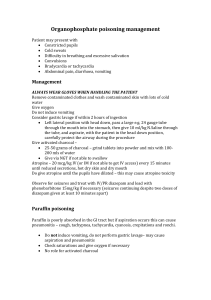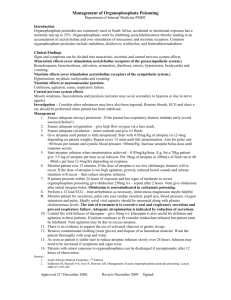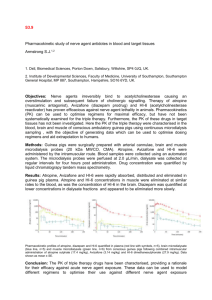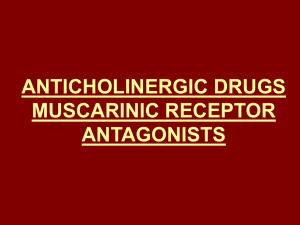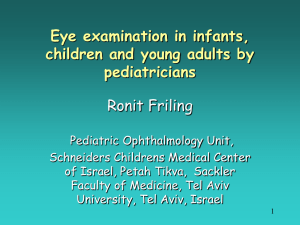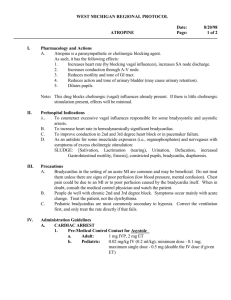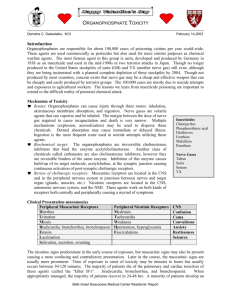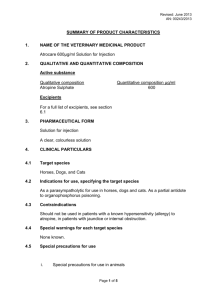1-Anticholinergic drugs
advertisement
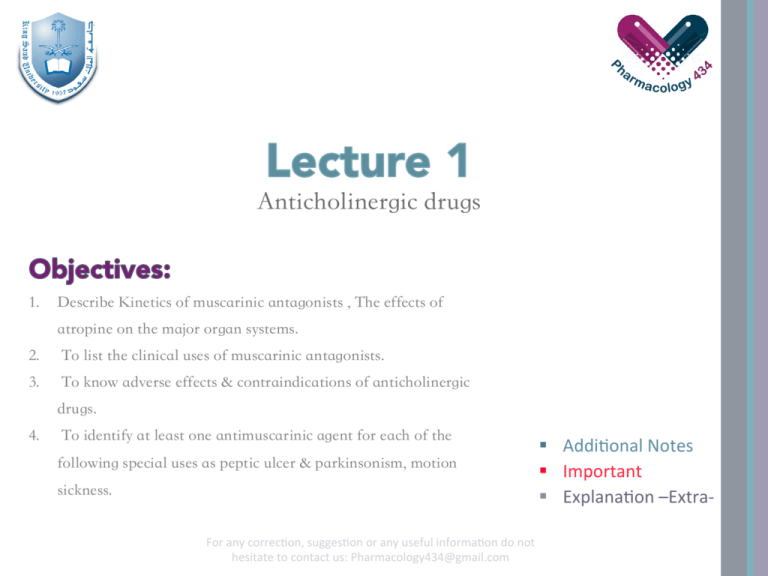
Anticholinergic drugs 1. Describe Kinetics of muscarinic antagonists , The effects of atropine on the major organ systems. 2. To list the clinical uses of muscarinic antagonists. 3. To know adverse effects & contraindications of anticholinergic drugs. 4. To identify at least one antimuscarinic agent for each of the following special uses as peptic ulcer & parkinsonism, motion sickness. For any correc-on, sugges-on or any useful informa-on do not hesitate to contact us: Pharmacology434@gmail.com § Addi-onal Notes § Important § Explana-on –Extra-­‐ Naturally occurring alkaloids e.g. Atropine, Hyoscine Anti-muscarinics synthetic atropine substitutes Anticholinergic drugs Ganglionic blockers Anti-nicotinics Neuromuscular blockers Organs Cholinergic ac#ons (substitutes for natural alkaloids made with limited action compared to to Atropine & hyoscine to reduce side effects) An#cholinergic ac#ons -­‐Contrac-on of circular muscle of iris (miosis) -­‐Contrac-on of ciliary muscles for near vision -­‐Decrease in intraocular pressure (IOP) -­‐relaxa-on (mydriasis) -­‐relaxa-on (cycloplegia) (loss of accommoda#on) -­‐Bradycardia ( decrease in heart rate ) -­‐Tachycardia (increase in heart rate ) -­‐Constric-on of bronchial smooth muscles (Bronchoconstric-on) -­‐Increase in bronchial secre-on -­‐dilata-on of bronchial smooth muscles (Bronchodilata-on) -­‐decrease in bronchial secre-on -­‐Increase in mo-lity (peristalsis) -­‐Increase in secre-on -­‐Relaxa-on of sphincter defeca-on (Diarrhea) -­‐decrease in mo-lity (peristalsis) -­‐decrease in secre-on -­‐contrac-on of sphincter defeca-on (cons-pa-on) Urinary Bladder -­‐Contrac-on of muscles -­‐Relaxa-on of sphincter -­‐Urina-on -­‐Relaxa-on of muscles -­‐contrac-on of sphincter -­‐ Urinary reten-on Exocrine glands -­‐Increase of secre-ons of exocrine glands, sweat, saliva, lacrimal (tears), bronchial, intes-nal secre-ons -­‐Decrease all secre-ons Eye Heart Endothelium Lung GIT An#cholinergic drugs: Drugs that block cholinergic receptors. So, when we block the muscarinic receptors – which are in parasympathe-c ANS – we ac-vate the ac-ons of the sympathe-c system. What does cycloplegia mean? Miosis (contrac-on of ciliary muscles) happens when the eyes try to focus on near subjects (near vision). In the other hand, Mydriasis happens for far vision. In normal situa-ons, when the sympathe-c NS is ac-vated, ciliary muscles of the eye relax causing mydriasis. At the same -me if you bring a close object to eye miosis will happen (contrac-on of ciliary muscles) to allow seeing the near object. In the other hand, pa-ents who have administered an-cholinergic drugs (e.g. Atropine toxicity), their ciliary muscles won’t be able to contract even if they want to see something near. That’s why the doctors use this method to detect an-cholinergic drugs administra-on or toxicity. So, Cycloplegia means: Paralysis of the ciliary muscles of the eye. THIS SLIDE IS DONE TO HELP YOU UNDERSTAND ONLY !! Nico-nic (Preganglionic) Neuronal nico-nic (Nn) In autonomic ganglia (central) Muscular nico-nic (Nm) In neuromuscular junc-on (peripheral) M1 Cholinergic M2 Muscarinic (Postganglionic) Receptors Adrenergic Autonomic NS M2 Alpha M4 Beta M5 Neurotransmitter in parasympathetic nervous system or cholinergic system is Acetylcholine and nerves are called Cholinergic nerves Postganglionic Preganglionic Ach Nicotinic receptor (Nn) Ach Muscarinic receptor Postganglionic Preganglionic Ach Somatic NS M3 Nicotinic receptor (Nn) NE Adrenergic receptor Nicotinic receptor (Nm) Ach No ganglia ! Muscarinic Antagonists Natural alkaloids: (come from plants so, they’re lipid soluble) (not selec-ve for the receptors) Drug MOA Dura-on of ac-on Effect on CVS Effect on CNS Effect on Urinary tract Effect on Respiratory system Atropine (protype) Reversible compe--ve blockade of all muscarinic receptors (not selec-ve) long -­‐ Tachycardia (increase in heart rate) -­‐ Therapeu-c dose: ↓ Vasodilata-on (doesn’t cause vasoconstric-on, but it cancels out the dilata-on happened by cholinergic ac-on) induced by cholinomime-cs. -­‐ Toxic dose: Cutaneous vasodilata-on (results from releasing of prostaglandin, not NO) → (Atropin flush). CNS depression (Seda-on), centrally An-eme-c effect (block vomi-ng center) and An--­‐parkinsonain effect (block basal ganglia) (in this disease, low Dopamine & high Ach, we can reduce the amount of Ach by an-cholinergic drugs) Toxic dose: Hyperthermia – excitement – hallucina#on. -­‐ Relaxa-on of smooth muscles of urinary bladder. (accommodates more urine) -­‐ Sphincter contrac-on à Urinary reten-on. -­‐ Relaxa-on of bronchial muscles (bronchodilator) -­‐ ↓ Bronchial secre-on → ↑ viscosity Effect on Eyes -­‐ Passive mydriasis (an-cholinergic drugs inhibits parasympathe-c system as a result, mydriasis occurs. Sympathe-c system causes ac#ve mydriasis). Due to paralysis of circular muscle. -­‐ Cycloplegia (loss of near accommoda-on) due to paralysis of ciliary muscle. -­‐ Loss of light reflex. -­‐ Increase I.O.P # glaucoma. (by relaxa-on of circular & ciliary muscles) -­‐ ↓ Lacrimal secre-on (tears) → sandy eye. Effect on Secre-ons ↓ Salivary secre-on → ( Dry mouth ). ↓ Swea-ng → dry skin → Fever in infants and children. (Atropine can’t be used in children even with therapeu-c dose). Effect on GIT Hyoscine Relaxa-on of smooth muscles. ↓ GIT mo-lity → An-spasmodic effect. ↑ Sphincter contrac-ons shorter than atropine Less CVS effect More CNS depressant ac-on More an-eme-c ac-on used in mo-on sickness Can produce Amnesia (loss of recent memory): used as an anesthe-c Pharmacokine#cs: -­‐for both Atropine and Hyoscine-­‐ • Lipid soluble • Good oral absorp-on • Good distribu-on • Cross blood brain barrier (have CNS ac-ons) Treatment of toxicity: • Gastric lavage. • An-convulsant. • Cooling blanket.(for hyperthermia) An#dote: Physos-gmine (lipid soluble=CNS effects) (IV slowly) (indirect ac-ng an-cholinesterase). Side effects: • Eye: Blurred vision – mydriasis • CVS: Tachycardia -­‐ atropine flush • UT: Urinary reten-on • GIT: Cons-pa-on(contracted sphincter), paraly-c ileus(decreased peristalsis) • Secre-ons: dryness of mouth , sandy eye, increased body temperature. • CNS: seda-on, hallucina-on, excita-on (toxic dose). Contraindica#on: Glaucoma (angle closure glaucoma), Tachycardia, Cons-pa-on Prostate hypertrophy in old pa-ents, Children (in case of Atropine à Hyperthermia). Synthetic atropine substitutes (selective = less side effects) Drug Benztropine organ CNS uses Parkinson's disease Homatropine Tropicamide Pirenzepine Respiratory system Stomach asthma, COPD, (used by inhalation to reduce side effects) Peptic ulcer Eye Fundus examination of eye Clinical uses of anti-muscarinic drugs: • • • • • • • Ipratropium Parkinsonism Vomiting Asthma Peptic ulcer. Intestinal spasm as antispasmodics Constipation Urinary urgency Uses of Atropine and Hyoscine (They work on CNS): • • • Pre-anesthetic medication Antispasmodic Motion sickness -Hyoscine Only- It has central antiemetic action à prevents dizziness and vomiting (It should be administrated before the the trip). Why do we use Atropine and Hyoscine as Pre-anesthetic medications? - Sedation effect. - During surgery Bradycardia could happen, so they prevent it from the beginning. - Decrease secretion of mucus to improve ventilation during surgery. Although they block parasympathetic actions. Why do anti-muscarinic drugs cause sedation? Because they play a role in blocking H1 receptors in the brain. ­ Summary Drug Atropine Hyoscine Kind Natural alkaloid (lipid soluble) Site of action Non-selective Benztropine Ipratropium Synthetic (Lesser side effects) • • • Pre-anesthetic medication Antispasmodic Motion sickness Eye Fundus examination of eye Respiratory system asthma, COPD, (used by inhalation to reduce side effects) Stomach Peptic ulcer Contraindication: - Glaucoma (angle closure glaucoma). - Tachycardia. - Constipation. - Prostate hypertrophy in old patients. - Children (Atropine à Hyperthermia). To understand the physiological part watch this video. Pre-anesthetic medication Antispasmodic Parkinson's disease Pirenzepine hdps://www.youtube.com/watch? v=OutqM2WENfo • • CNS Homatropine Tropicamide Uses Toxic effect of Atropine : - Dry mouth . - Inhibition of sweating. - Tachycardia and cutaneous vasodilation. - Blurring of vision. - Hallucination. Mnemonic to help you remember: “Dry as a bone, Hot as a hare, Red as a beet, Blind as a bat, Mad as a hatter” ­ MCQs 2. Which is a characteristic of Natural Alkaloids? A) Poor absorption B) Poor distribution C) Polar D) Cross BBB 3. Which is not a Synthetic Atropine Substitute? A) Benztropine B) Ipratropium C) Oxybutynin D) Hyoscine 4. Effect of Atropine on CVS? A) Bradycardia B) Sedation C) Positive dromotropic effect D) Increased viscosity 5. Which does not act on CNS? A) Atropine B) Hyoscine C) Homatropine D) Benztropine 6. Which is true for Hyoscine? A) Long duration of action B) Less CNS depressant action C) Less CVS effect D) Less used in motion sickness Answers: 1-­‐ A 2-­‐ D 3-­‐ D 4-­‐ C 5-­‐ C 6-­‐ C 1. Which is not an example of Antimuscarinics? A) Neuromuscular blockers B) Glycopyrrolate C) Atropine D) Hyoscine Good luck! Done by Pharmacology team 434 Moneera Al Draihem Maha Al-Rabiah Mesha’al Hussain Khulud Al Enzy Hanan Muhammad Noha Al Gwaiz Muhammad Kharraz For any correc-on, sugges-on or any useful informa-on do not hesitate to contact us: Pharmacology434@gmail.com

